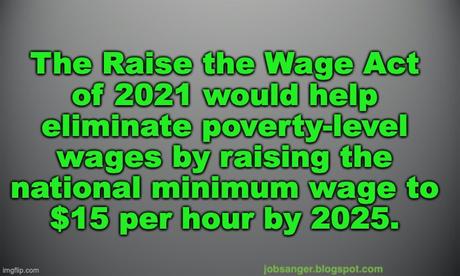
The following facts about raising the minimum wage to $15 an hour is from the Economic Policy Institute
The raise is long overdue and would deliver broad benefits to workers and the economy.
- The current federal minimum wage is $7.25 per hour and has not been raised in over 10 years. A full-time federal minimum wage worker today earns 18% less than what her counterpart earned at the time of the last increase, after adjusting for rising costs of living ($15,080 annually in 2021 versus $18,458 in 2009).
- In 1968, a minimum wage worker earned $10.59 per hour in inflation-adjusted terms, 46% more than today’s $7.25 federal minimum wage. The minimum wage today would be over $22 per hour had it tracked productivity increases over the last five decades.
- The Raise the Wage Act of 2021, which phases in a $15 minimum wage by 2025, would raise the earnings of 32 million workers, or 21% of the workforce.Affected workers include those who would see their wages rise as the new minimum wage rate exceeds their current hourly pay and those who have a wage rate just above the new minimum wage who would receive a raise as employer pay scales are adjusted upward to reflect the new minimum wage.
- On average, an affected worker who works year round would see an annual pay increase of about $3,300. In total, a $15 minimum wage would provide over $108 billion in additional wages in 2025 to affected workers.
- A national minimum wage of $15 delivers on a core demand of the Civil Rights movement. The March on Washington in 1963 (the March on Washington for Jobs and Freedom) demanded a $2.00 national minimum wage that would be equivalent to $15.00 today, after adjusting for inflation.
- Earnings would rise for nearly one in three Black workers (31%) and for one in four Hispanic workers (26%), compared with about one in five white workers.For Black and Hispanic workers who work year round, annual pay would increase by at least $3,500.
- $15 minimum wage by 2025 would raise the wages of at least 19 million essential and front-line workers. Essential and front-line workers constitute more than 60% of all workers who would see a pay increase.
- Workers who cannot work from home—who are more likely to be Black, Latinx, and Native American—are the overwhelming majority of workers (almost nine out of every 10) who would receive pay raises under the Raise the Wage Act of 2021.
- The Raise the Wage Act would help eliminate poverty wages. Raising the minimum wage to $15 in 2025 would lift up to 3.7 million—including an estimated 1.3 million children—out of poverty.
- Raising the minimum wage to $15 would help ensure that more low-wage workers are paid enough to cover basic living expenses, i.e., a wage providing a modest yet adequate standard of living. As of 2021, in virtually all urban and rural areas of the country, a single adult without children working full time must earn more than $15 per hour to have enough to pay for housing and other basic living expenses. For individuals with children, year-round work at a $15 wage in 2025 will still be inadequate to achieve basic economic security.
- Minimum wage increases have not led to significant job losses. Despite claims that raising the minimum wage would reduce job opportunities for vulnerable groups of workers, the best evidence shows little to no job losses in the wake of minimum wage increases and a net wage gain even if job losses have occurred. These benefits explain why surveys show that the people most likely to support a minimum wage increase are unemployed people, people of color, and women.
- Minimum wage increases affect adults in their career-building years who are helping to support their families—with women disproportionately benefiting from a pay boost. The average age of workers who would see a pay increase under the Raise the Wage Act is 35 years old. About 90% of those with increased wages would be adults age 20 or older. Most of the workers who would benefit are women (59%) even though men are a majority of the workforce. More than half of those who would have higher pay work full time (59%). Past research shows that these workers are often the primary earners for their families, producing the majority of their family’s total income.

